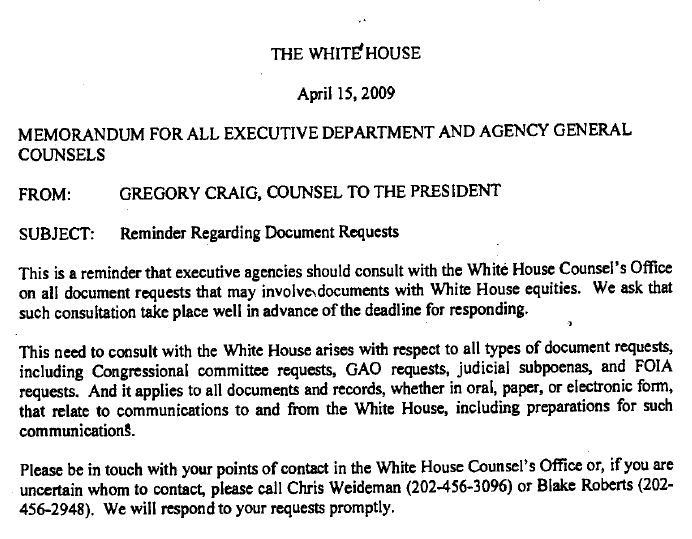This post is Part II in a series discussing the lawsuit from the Center for Biological Diversity. Part I is available here.
The joint resolution disapproving the Refuges Rule was a proper use of the CRA’s look-back provision. But even if it wasn’t, a court is unlikely to overturn the resolution on that basis.
A joint resolution disapproving an agency rule via the Congressional Review Act (“CRA”) really only differs from any other law invalidating a regulation in two respects. First, it allows the Senate to pass the resolution without needing sixty votes to end debate. The 60 vote necessity to do so for other legislation is not a Constitutional mandate. And second, it prohibits the agency from reissuing the rule in substantially the same from. The latter provision could be added to any piece of legislation overturning a regulation, so all that is really at stake is whether the Senate may operate under expedited procedures and a lower vote threshold.
The CRA requires a disapproval resolution to be introduced within sixty days of the agency submitting the requisite report to Congress.[1] But if the report is submitted within the final sixty legislative days of a congressional session, then that report is considered to have been submitted on the fifteenth legislative day of the new Congress.[2] This is known as the look-back provision and it is designed to allow a new Congress to review all of the midnight rules rushed out the door at the end of the previous Congress. The look-back provision is especially important after an election year when a lame-duck administration tries to push through an aggressive regulatory agenda for the incoming administration to unravel.
In its lawsuit, the Center for Biological Diversity claims that the Refuges Rule was not eligible for the CRA’s look-back scheduling provision because it qualifies as a hunting regulation that is exempt from Section 801’s reporting requirements by Section 808.[3] This claim fails for at least two reasons. First, the look-back provision is an internal congressional scheduling rule, which is the type of rule courts often avoid under the political-question doctrine. Second, the Refuges Rules does not qualify as a hunting rule under the Section 808 exemption and was thus properly subject to the look-back provision.
The interpretation of internal congressional rules is a political question that courts often avoid.
Congress creates its own rules of administration and courts are loath to meddle in them. The Constitution states that “[e]ach House may determine the rules of its proceedings[.]”[4] Legal challenges to those rules often implicate the political question doctrine, under which courts avoid cases where there has been a “textually demonstrable constitutional commitment of the issue to a coordinate political department.”[5]
One example is Metzenbaum v. Federal Energy Regulatory Commission, where the D.C. Circuit found that judicial interpretations of congressional rules is inappropriate because “there is ordinarily ‘no warrant for the judiciary to interfere with the internal procedures of Congress.’”[6] “To decide otherwise would subject Congressional enactments to the threat of judicial invalidation on each occasion of dispute over the content or effect of a House or Senate rule. The majority having given its sanction to legislation, and implicitly the process followed in its enactment, a minority might yet frustrate its implementation through litigation based on purported violations of ‘housekeeping’ rules.”[7] One exception to this rule is where the “rights of persons other than members of Congress are jeopardized by Congressional failure to follow its own procedures[.]”[8] This approach has given rise to the so-called “enrolled bill rule,” which holds that “if a legislative document is authenticated in regular form by the appropriate officials, the courts treat that document as properly adopted.”[9] This rule stretches all the way back to the Supreme Court’s 1892 decision in Field v. Clark.[10]
Here, the CRA is clear that the look-back provision is nothing more than a scheduling rule of Congress:
This section is enacted by Congress as an exercise of the rulemaking power of the Senate and House of Representatives, respectively, and as such it is deemed a part of the rules of each House, respectively, but applicable only with respect to the procedure to be followed in that House in the case of a joint resolution[.][11]
There does not appear to be any contention that the joint resolution was improperly voted on or incorrectly enrolled by the congressional officials upon its passage. The Center for Biological Diversity merely claims that Congress should have determined that the Refuges Rule was ineligible for the look-back provision. But Congress did make that determination, and courts are typically hesitant to get involved in such matters.
This conclusion is buttressed by the fact that the CRA expressly precludes judicial review of congressional determinations made under the CRA. Section 805 states that “[n]o determination, finding, action, or omission under this chapter shall be subject to judicial review.”[12] The determination made by both chambers of Congress that the Refuges Rule qualifies for the look-back scheduling provision is precisely the type of “determination” that the CRA exempts from judicial review.
The Refuges Rule does not qualify for the Section 808 exemption.
Despite theCenter for Biological Diversity’s claim, the Refuges Rule does not fall within the CRA’s Section 808 exception. The CRA provides that “[b]efore a rule can take effect,” the agency promulgating the rule must submit a report to Congress.[13] Section 808 provides that notwithstanding that requirement, a rule may take effect at such time as the agency decides if the rule “establishes, modifies, opens, closes, or conducts a regulatory program for a commercial, recreational, or subsistence activity related to hunting, fishing, or camping[.]”[14] The Center for Biological Diversity claims that the “Refuges Rule is covered by the plain language of Section 808 . . . [b]ecause it disallows certain hunting practices that may be approved by the Board[.]”[15]
Although the Center for Biological Diversity is correct that the Refuges Rule affects hunting practices, it makes no attempt to argue that the regulation impacts “a regulatory program” aimed at “commercial, recreational, or subsistence activity.” By its plain terms, the Refuges Rule is not directed at subsistence activity; it is titled “Non-Subsistence Take of Wildlife”[16] and the Center for Biological Diversity admits in its complaint that the rule does not affect takes “for subsistence by federally-qualified subsistence users.”[17] The rule also does not affect either commercial or recreational activity but is instead aimed at “the conservation of natural and biological diversity, biological integrity, and environmental health on refuges in Alaska[.]”[18] The rule focuses on “predator control” by “prohibit[ing] several particularly effective methods and means for take of predators[.]”[19] The U.S. Fish and Wildlife Service (“FWS”) “define[s] predator control as the intention to reduce the population of predators for the benefit of prey species.”[20] This includes practices “such as . . . those undertaken by government officials or authorized agents, aerial shooting, or same-day airborne take of predators. Other less intrusive predator reduction techniques such as . . . live trapping and transfer, authorization of particularly effective public harvest methods and means, or utilizing physical or mechanical protections (barriers, fences) are also included[.]”[21]
The Refuges Rule does not affect a regulatory program involving commercial licenses, recreational takes, or any type of nonconsumptive recreational use, such as wildlife viewing or photography. The Refuges Rule is a conservation regulation, which is not included among Section 808’s exceptions.
FWS is clear about this in its final rule. In response to a commenter concerned that the regulation would impact ecotourism, FWS responded: “Although this rule may result in slight changes in refuge visitor experiences, we do not expect this rule to significantly impact visitors engaged in either hunting or nonconsumptive uses like wildlife viewing.”[22] FWS also wrote that “there may be slight effects to recreational big game hunting on refuges by eliminating a hunter’s ability to use a few specific methods and means of take. However, until recent years, many of these methods and means were prohibited Statewide.”[23] FWS inclusion of passing references to “slight changes” and “slight effects” to recreational activities demonstrates that the Refuges Rule does not establish, modify, open, close, or conduct “a regulatory program” related to commercial or recreational activities. At most, it may have slight impacts on other regulatory programs not included in this rule.[24]
Therefore, the Refuges Rule does not qualify for the CRA’s Section 808 exception and all of Center for Biological Diversity’s arguments that follow from that characterization (i.e., that the Refuges Rule is not eligible for the look-back provision) must fail.
James Valvo is Counsel & Senior Policy Advisor at Cause of Action Institute and you can follow him on Twitter @JamesValvo.
[1] 5 U.S.C. § 802(a).
[2] Id. § 801(d)(1).
[3] Id.
[4] U.S. Const. art. 1, § 5, cl. 2.
[5] Baker v. Carr, 369 U.S. 186, 217 (1962).
[6] 675 F.2d 1282, 1287 (D.C. Cir. 1982) (citing Exxon Corp. v. FTC, 589 F.2d 582, 590 (D.C.Cir.1978)); see also Christoffel v. United States, 338 U.S. 84, 88–89 (1949) (“Congressional practice in the transaction of ordinary legislative business is of course none of our concern, and by the same token the considerations which may lead Congress as a matter of legislative practice to treat as valid the conduct of its committees do not control the issue before us.”); Mester Mfg. Co. v. INS, 879 F.2d 561, 571 (9th Cir. 1989) (“In the absence of express constitutional direction, we defer to the reasonable procedures Congress has ordained for its internal business.”).
[7] Metzenbaum, 675 F.2d at 1287.
[8] Id.; see also United States v. Rostenkowski, 59 F.3d 1291, 1305 (D.C. Cir.), opinion supplemented on denial of reh’g, 68 F.3d 489 (D.C. Cir. 1995) (The “Rulemaking Clause is not an absolute bar to judicial interpretation of the House Rules.”).
[9] United States v. Sitka, 845 F.2d 43, 46 (2d Cir. 1988) (citing United States v. Thomas, 788 F.2d 1250, 1253 (7th Cir. 1986)).
[10] 143 U.S. 649 (1892).
[11] 5 U.S.C. § 802(g).
[12] Id. § 805.
[13] Id. § 801(a)(1)(A).
[14] Id. § 808(1). This section also exempts “any rule which an agency for good cause finds (and incorporates the finding and a brief statement of reasons therefor in the rule issued) that notice and public procedure thereon are impracticable, unnecessary, or contrary to the public interest[.]” Id. § 808(2). Although the CRA’s legislative history makes passing reference to the section 808(1) delay, it does not provide a reason for why Congress included this provision. See 142 Cong. Rec. S3683-01, S3685 (Apr. 18, 1996).
[15] CBD Compl. ¶ 58 (citing 5 U.S.C. § 808).
[16] “Non-Subsistence Take of Wildlife, and Public Participation and Closure Procedures, on National Wildlife Refuges in Alaska,” 81 Fed. Reg. 52,247 (August 5, 2016) (the “Refuges Rule”); Id. at 52,247 (“This rule does not change Federal subsistence regulations or restrict the taking of fish or wildlife for subsistence uses under Federal subsistence regulations.”).
[17] CBD Compl. ¶ 37 (“The regulations do not change Federal subsistence regulations or otherwise restrict the taking of fish or wildlife for subsistence by federally-qualified subsistence users.”).
[18] Refuges Rule, 81 Fed. Reg. at 52,247.
[19] Id.
[20] Id. at 52,252.
[21] Id.
[22] Id. at 52,260.
[23] Id.
[24] 5 U.S.C. § 808(1).



